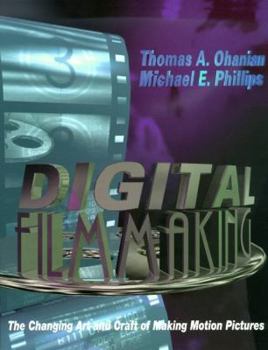Digital Filmmaking: The Changing Art and Craft of Making Motion Pictures
Select Format
Select Condition 
Book Overview
Digital Filmmaking has been called the bible for professional filmmakers in the digital age. It details all of the procedural, creative, and technical aspects of pre-production, production, and... This description may be from another edition of this product.
Format:Paperback
Language:English
ISBN:0240802195
ISBN13:9780240802190
Release Date:March 1996
Publisher:Focal Press
Length:267 Pages
Weight:1.55 lbs.
Dimensions:0.6" x 8.5" x 11.0"
Customer Reviews
3 ratings
Covers a lot of difficult technical ground
Published by Thriftbooks.com User , 22 years ago
While the writing sytle and the overall style of the book seems to ramble, there's actually a whole lot of very important technical information being covered in this book.It's reassuring to me to have industry specialists writing a technical book as well as interview other working professionals. While the 1st edition might seem a little dated, the 2nd edition includes more information on 24P HD, among other things. The film information is very thorough and well-explained, and that's not usually the case! The same is true for the various audio issues to consider both in the field and in post. It's also one of the few books that provides information on the use of film timecode.
Will video replace film?
Published by Thriftbooks.com User , 24 years ago
This fabulous book is a must for anyone considering shooting a project on digital video or HDTV. Timely issues are addressed, such as what happens when you shoot video (approx. 30fps) and then transfer to film (24fps). One of the chapters is titled, "24p: Twenty-Four Frames, Progressively Scanned." 24p and video was a major issue at the NAB Convention (National Association of Broadcasters) last April. The book describes the new digital frontier, and also takes time to review traditional film making process. Also, rather than just deal with digital cameras and nonlinear editing, Ohanian and Phillips also take a look at digital technology uses in other areas of film such as storyboard and costume design. There is even a section on the use of Storyboard Quick and an industry viewpoint with Storyboard Quick's co-developer, Paul Clatworthy writing about the future of digital previsualization. These highlighted areas, called "Industry Viewpoints" create compelling interest throughout each chapter where industry experts such as editor Pietro Scalia (JFK-Academy Award for best editing) contribute much insight.Will film editing and other traditional film methods become obsolete is a question the book addresses. The authors point out the many innovations that editors have achieved, moving from film to digital video editing, such as the method of "cheap telecine." Here, the editor uses the conventional flatbed film editor modified to include a CCD camera. Rather than spend thousands transferring at a facility, the editor simply transfers with his flatbed and then edits on an Avid or other nonlinear system. This is so much faster than film editing.Digital Consultant Van Ling points out that "like in many fields, it (digital technology) can be easy to fall into the temptation of the technological imperative it that if the technology is out there, you should be using it or you'll be behind the times." He continues, stating that filmmakers need to focus on "weaving a good yarn." The authors stress that "adoption of a new methodology or a new technology must take into account two issues: 1) does the new way decrease the cost of getting the film into distribution, or 2) is there a different benefit, such as increased creativity?" Any filmmaker who knows how to harness the digital technology with taste and creativity so the story telling is enhanced will be the successful storyteller.The second edition looks at industry standard programs such as Movie Magic Budgeting and unveils many unique features. Digital technology has influenced today's film making from script, budget, storyboarding, and costume design programs to the way the film or digital video is shot. The Director of Photography often has his laptop near the camera with storyboards loaded. Many camera operators now wear on their belt a BE Logger which is a wireless time code reader. The logger detects camera starts and stops for automatic logging of
The 2nd Edition of this book just arrived!
Published by Thriftbooks.com User , 24 years ago
The Second Edition was published April 2000 and has a considerable amount of material about 24p and transferring DV or HDTV to 35mm motion picture footage. It is also an invaluable guide at gaining some insight into the changing world of film making.






